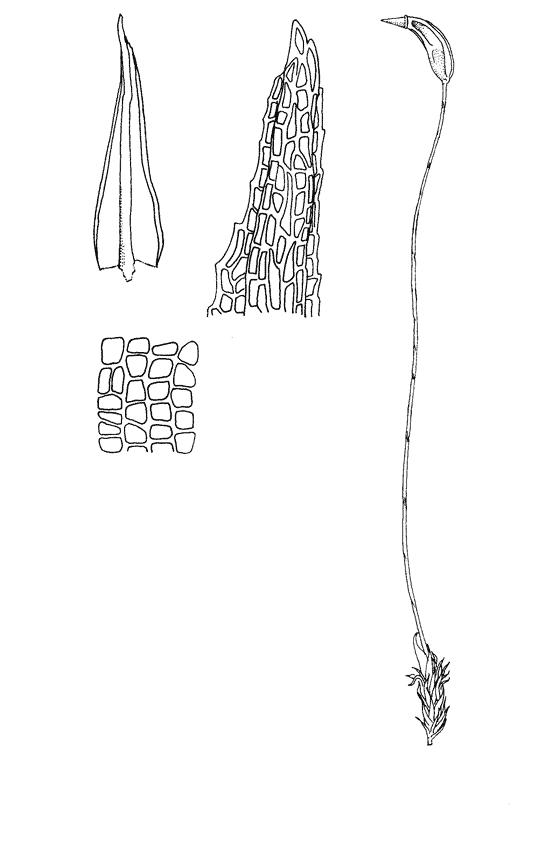Plants to 4 cm high in dense to loose turfs, yellow-green to olive-green or, in exposed sites, red-brown. Leaves crispate when dry, spreading when moist, to 2 mm long, 3–5: 1, lanceolate to ovate-lanceolate, keeled above, gradually narrowed from near the base to the acute apex. Median cells quadrate, smooth, to 10 µm broad, 1–1.5: 1, in very regular rows, with lumen/wall ratio about 5: 1 and with rounded lumens due to small corner thickenings. Marginal cells mostly like those of the adjacent lamina but sometimes rectangular, to 4: 1. Basal cells, especially those of the juxtacostal region, to 14 µm broad, to 5: 1, rectangular and pellucid with straight lateral walls, arranged in regular rows, moderately thick-walled with the lumen/wall ratio about 2: 1, not pitted. Cells of abaxial costal surface similar to those of lamina; those of adaxial costa rectangular, 3–8: 1, to 10 µm wide. Costa occupying 1/8 of leaf base, gradually tapering and percurrent to shortly excurrent. Costa cross-section with a single layer of guide cells and with two strong stereids and a well-differentiated abaxial epidermis. Margin recurved from near the base to near the apex, remotely and often inconspicuously serrulate at least near the apex. Axillary hairs to 150 µm, 3-celled, with one basal brown cell. Stem with central strand, very thin walled throughout except for a one or two layers of thicker waller, much smaller outer cortical cells.
Dioicous. Perichaetial leaves oblong, convolute and sheathing seta, to 4 mm long, truncate and often long mucronate at apex. Seta to 30 mm, dark and glossy red brown, occasionally yellow brown with age straight, smooth. Capsule glossy reddish to purplish. Urn cylindrical but broadest at base, inclined to horizontal, asymmetric, to 2 mm long, about 2–4: 1, usually strongly sulcate and strumose. Annulus well-differentiated and revoluble. Operculum conic, to 1 mm long. Peristome reddish-brown, to 300 µm long, finely papillose throughout, bifid into filiform segments nearly to base. Exothecial cells more or less rectangular with oblique end-walls, not in regular rows, to 18 µm wide, to 6: 1, rather thin-walled. Stomata abundant on neck. Spores spherical, to 14 µm, nearly smooth.
This may be the most abundant moss in the world, being found on every continent including Antarctica and being a normal occupant of a great variety of ruderal habitats, especially recently burned or high nitrogen areas. In tropical latitudes it is replaced by the probably conspecific C. stenocarpus Bruch & Schimp. ex C. Muell. Ceratodon purpureus may be recognised by the ovate-lanceolate leaves with strongly recurved margins which are distally remotely toothed. The capsules are absolutely diagnostic: glossy purplish strumose structures which are strongly sulcate after dehiscence.
| Literature | Bourell 1981; Bradshaw 1926; Crum and Anderson 1981; Harpel 1980a; Harthill et al. 1979; Holmberg 1969; Kellman 2003; Koch 1950a, 1951e, 1958; Koch and Ikenberry 1954; Lawton 1971; Lesquereux 1868; Long 1978; McCleary 1972; McGrew 1976; Mishler 1978; Sayre 1940; Shevock and Toren 2001; Showers 1982; Smith 1970; Spjut 1971; Steere 1954; Steere et al. 1954; Strid 1974; Toren 1977; Watson 1880; Whittemore and Sommers 1999; Yurky 1990. As Ceratodon purpureus var. xanthopus Lesquereux 1868; Sullivant 1856; Watson 1880. |
| Illustrations | Malcolm et al. 2009 p. 89; Crum and Anderson 1981; Flowers 1973; Ignatov and Ignatova 2003; Ireland 1982; Lawton 1971; Ochyra 1998a; Sharp et al. 1994; Smith 1978; Zander and Ireland 1979. |
| Bioregions | CaR, CW, GV, MP, NW, SN, SNE, SW. |
| Vouchers | Butte Co.: levee of Feather River north of Gridley, Norris 52540; Modoc Co.: near Mayfield Ice Caves (Siskiyou Co.), Norris & Hermann 22519; San Diego Co.: Cameron Station Campground, Cleveland National Forest, Norris 57804; San Francisco Co.: Twin Peaks, San Francisco, Shevock 18862 & 19142; Sonoma Co.: South Ridge Trail above Lake Sonoma at Skaggs Springs Road, Norris 86938; Tulare Co.: Chamise Flats along Kern River 2.3 miles south of Roads End, Sequoia National Forest, Shevock, Norris, & Barahona 13028. |
·
![University of California [UC]](http://ucjeps.berkeley.edu/common/images/logo_uc_80.png)
![University of California [UC]](http://ucjeps.berkeley.edu/common/images/logo_uc_80.png)
